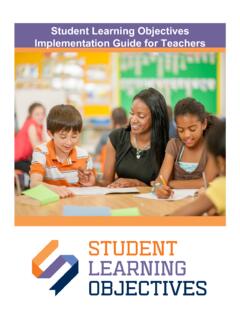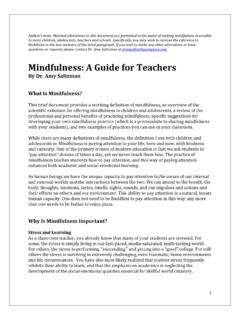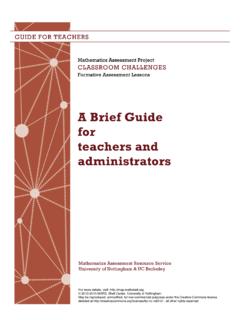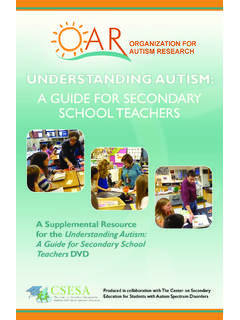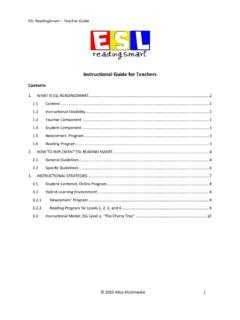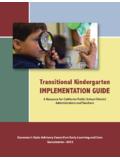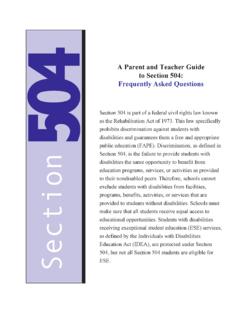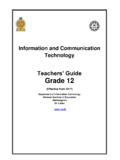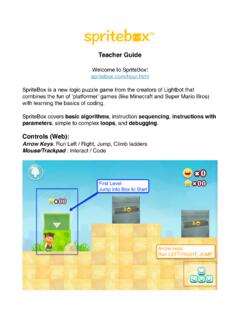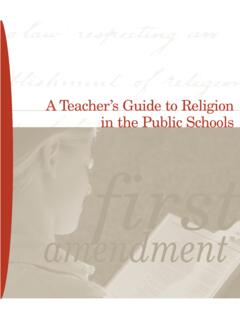Transcription of Teachers’ Implementation Guide to Student …
1 Teachers Implementation Guide to Student learning Objectives 2017- 2018 This document is designed to provide teachers with a step-by-step Guide to the development of Student learning Objectives (SLOs). The goal is to provide teachers with a strategy for SLO development, monitoring, and reflection on outcomes. Additional SLO samples will be provided on the website. [This page intentionally left blank.] Table of Contents Table of Contents .. 3 Using this SLO Handbook .. 4 The Texas Student learning Objective Process .. 7 Phase 1: Creating a Student learning Objective .. 8 Question 1: What is the focus for my SLO? .. 8 Question 2: Who are my students ?
2 12 Question 3: What are my expectations for these students ? .. 16 Question 4: How will I Guide these students toward growth? .. 21 Phase 2: Monitoring Progress to Drive Instruction .. 24 Question 5: Are my students progressing toward targets? .. 24 Phase 3: Evaluating Success and Reflecting .. 27 Question 6: Did students grow and what did I learn from the process? .. 27 Final Thoughts: Student learning Objectives .. 30 Appendix A: SLO Form .. 31 Appendix B: Student Growth Tracker .. 35 Appendix C: SLO Rating Rubrics .. 36 Appendix D: SLO Quality Tool .. 38 Appendix E: Progress Discussion Notes (Optional) .. 40 Appendix F: End-of -Year Reflection .. 41 Appendix G: Definitions for the SLO Process.
3 42 Teachers SLO Implementation Guide | June 2016 4 | Page Using this SLO Handbook The purpose of this Implementation Guide is to provide step-by-step information about crafting, implementing, and reflecting on SLOs. This guidance is not designed as a stand-alone resource for SLO Implementation but should accompany training on the SLO process and support throughout the year. It is designed to follow the steps in the SLO Thinking Map (see p. 5). Teachers will be able to find support on a particular step by locating the general question in the table of contents and jumping to that section of the Guide . Teachers SLO Implementation Guide | June 2016 5 | Page What are Student learning Objectives?
4 Excellent teachers regularly set learning goals for their students and use a variety of data sources to monitor progress towards these goals throughout the year. The Student learning Objectives process aims to capture this best practice as a means to allowing teachers and teacher appraisers to determine and reflect on a teacher s pedagogical strengths and areas for growth. Student learning Objectives are: Student growth goals Set by teachers Focused on a foundational Student skill that is developed throughout the curriculum Tailored to the context of individual students Designed to help teachers better understand the impact of their pedagogy For the purposes of refining instruction.
5 Why use Student learning Objectives (SLOs) as a Measure of Student Growth? SLOs drive both teacher practice and Student learning by strengthening instruction. The use of SLOs has been associated with improved Student outcomes on standardized assessments. Teachers crafting SLOs report improved understanding of how to use data to determine Student needs and to measure progress toward goals. SLOs encourage collaboration among teaching peers as well as between teachers and their appraisers. And, SLOs encourage the adoption of a long-term vision for Student learning and contribute to more meaningful discussions about vertical planning. Teachers SLO Implementation Guide | June 2016 6 | Page Teachers SLO Implementation Guide | June 2016 7 | Page The Texas Student learning Objective Process Process Overview and Planning Considerations The Student learning Objective process should be used throughout the school year to help teachers plan backward from an end vision for Student success.
6 This process helps encourage regular conversations and collaboration between teachers, students , and appraisers in order to ensure that instruction facilitates students progress toward growth goals. The SLO process represents a continuous cycle of improvement embodied in strong teaching practice. Teachers and their appraisers will use SLOs to design strategies to meet their goals for Student success, beginning with planning and leading to thoughtful instructional design and delivery. Throughout the year, teachers will collect evidence of Student learning and adjust instruction accordingly. At the end of the cycle, teachers will reflect on outcomes and plan to refine their practice for the following year.
7 For ease of understanding, the SLO process has been grouped into three key phases to define the sequence of actions to be taken. Phase 1: Creating a Student learning Objective The first phase focuses on purposeful planning of instruction. At the beginning of the course, teachers work with each other, their appraisers, and other support staff to identify foundational skills to address, create an instructional plan, and identify Student starting points as the SLO is crafted. During this phase, teachers will develop and articulate a clear vision for Student growth and strategies to be used to monitor progress toward those goals. Phase 2: Monitoring Progress to Drive Instruction After the Student learning Objective is completed and approved by the appraiser, teachers will work with each other and their appraiser, engaging in ongoing dialogue about progress toward goals.
8 These discussions will also be opportunities for teachers to receive feedback and support, and to develop strategies to adjust instruction based on progress monitoring findings. To improve efficiency in Implementation , SLO processes should be integrated into existing support frameworks at each school. Phase 3: Evaluating Success and Reflection This last phase takes place at the end of the course and includes a conversation between the teacher and his or her appraiser regarding the quality of the SLO, the level of expectations for Student growth, the teacher s effectiveness at monitoring students progress and adjusting instruction, and how well students did in meeting or exceeding growth targets.
9 This conversation results in an overall rating that is based on these factors. The final conversation is designed to help teachers and appraisers reflect on Student progress and teacher practice throughout the course in order to plan for the refinement of instruction for the following year. Teachers SLO Implementation Guide | June 2016 8 | Page Phase 1: Creating a Student learning Objective Phase 1 will occur over the first 1-2 months of school for yearlong courses, or in the first 3-4 weeks for semester courses. During Phase 1, teachers will work with other teachers and with their appraiser to develop Student learning Objective(s) for one or more selected courses. Although teachers will use the Student learning Objective form (Appendix A) to craft the SLO, the form simply captures the thinking prompted by the first four overarching questions found on the SLO Thinking Map (see p.)
10 5). Following the guidance below, teachers will spend time gathering resources and information to complete Steps 1 through 5. To improve the quality of the SLO, teachers may wish to refer to the SLO Quality Tool (Appendix D). Question 1: What is the focus for my SLO? The goal of this step is to identify a foundational skill for this course that would be appropriate for the focus an SLO. This skill should be the must have for students in the course. To determine the foundational skill, teachers should ask themselves, When students leave my course, what is the one thing they must be able to do as they move forward in their education? Typically the answer to this question will be the skill identified for the SLO.
